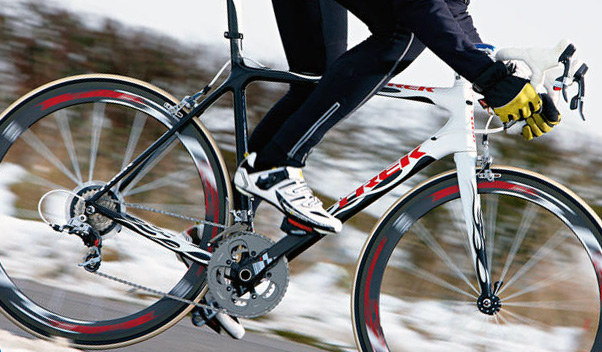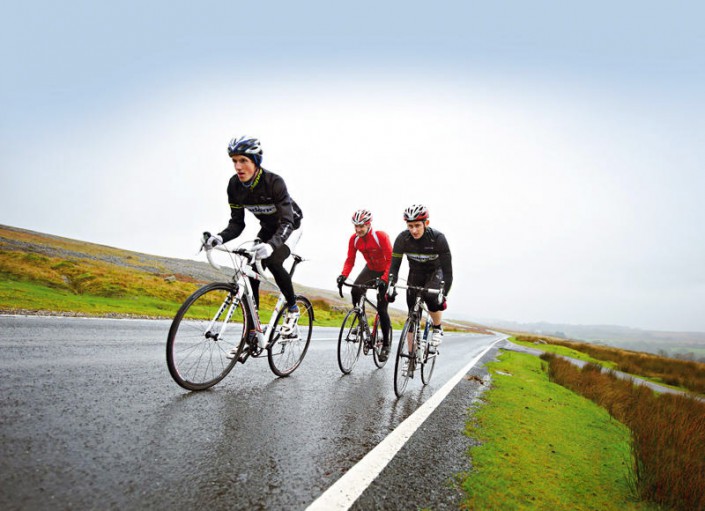Just the thought of winter riding is enough to deter even the most hardened riders. A turbo trainer or even a cozy bed may seem more preferable than battling with ice, rain, wet snow, and piercing winds in an attempt to stay in the saddle and keep warm.
But with the right equipment and our advice, you can still go out and reap the same benefits for your body and health as you would in the summer. Many coaches and seasoned riders who ride all year round claim that conquering the elements helps strengthen willpower, and that will come in handy during races, sporting events, and challenging summer trips.

Ice
Black ice and frost on the roads can catch anyone off guard, especially when the crisp freshness of winter and clear blue sky invite you for an invigorating bike ride. Beautiful cloudless days go hand in hand with freezing nights. And when the sun rises, it doesn’t climb high and warm up the ground, casting long shadows.
Add to this the inconvenient habit of cyclists riding in the mornings, and you may find yourself in a situation where one of those shadows turns into an icy patch, causing the wheels to lose traction with the road.
The main cause of black ice formation is sudden cold temperatures following a slight thaw. Melting or rainwater doesn’t have enough time to evaporate from the road surface, creating a thin layer of transparent ice.
When riding in such conditions, carefully plan your route, choosing only familiar paths. The problem is that local authorities often use anti-icing agents along with salt, which keeps the road slippery for several more days.

Shaded areas of the road thaw last
In particular, beware of open sections of the road where there are no buildings or fences – strong winds additionally cool the asphalt – and always look ahead for dangerous places that should be avoided if it can be done safely and without haste.
If you have to ride on ice, do not make sudden movements, do not brake or turn too hard or abruptly, keep the bike steady. Of course, if a frozen puddle catches you on a downhill curve, all you can hope for is a soft landing.
Wet roads
Riding on a wet road can be fun, but you need to be more careful. The braking distance becomes longer because moisture gets between the braking surface and the brake pads. Don’t forget about this.
In addition, road markings become slippery, as well as sewer covers and grates. When passing over them, be more cautious, especially on turns. It’s best to avoid them altogether, but if there’s no choice, then plan your trajectory and speed in advance. A sudden turn on wet metal or paint often leads to a fall.
We recommend using both the rear and front brakes equally, and also staying away from the roadside where all the dirt and small stones are washed onto the road, causing punctures.

Strong wind
Some call it the “invisible hill” – the wind can turn a flat road into a challenging climb. Here’s another reason to go for a ride.
Increased air resistance hinders your movements, raises your heart rate, energy expenditure, and muscle tension, simulating uphill riding if you live in a flat area. Just like riding in the rain, these difficulties will get you accustomed to tough conditions.
Anyone who has tried it themselves – or simply observed athletes – will confirm that the best way to fight the wind is to ride in a group. Riding behind one rider at a speed of 30 km/h reduces energy expenditure by 18%, at 40 km/h – by 27%, and in a group – by 39%.
Riding together with friends will help you cope with bad weather both psychologically and physically.
But what if you have to ride alone? Avoid the wind in narrow streets and plan your route so that it blows at your back on the way back. This noticeably increases your speed.
When things are really bad, lean closer to the handlebars, as it slightly reduces air resistance. If the wind is sharp and gusty, choose a lower gear, stay closer to the middle of the road, and hold onto the handlebars tighter to be able to adjust your trajectory in time.
If you are trying to maintain a certain energy expenditure or heart rate, you need to increase or decrease your pace according to the wind speed. And when the wind speed approaches stormy levels, it’s better to stay home and exercise on a stationary bike.
 info@velo.bike
info@velo.bike